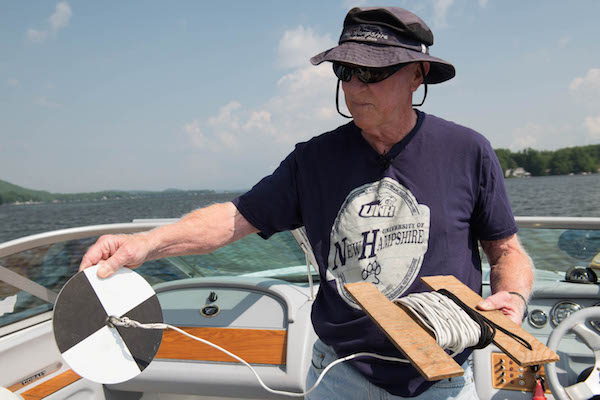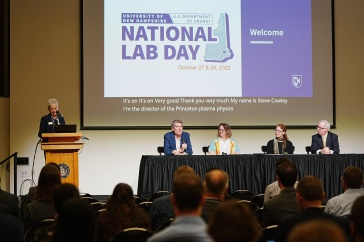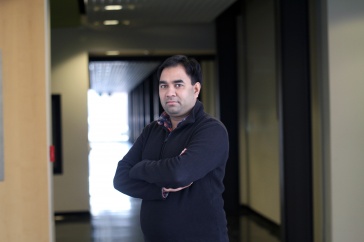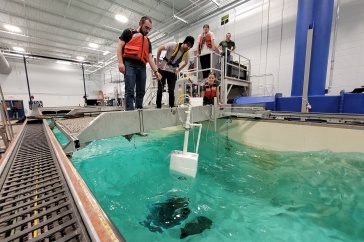Paul Richardson of Alton says volunteering with UNH's Lakes Lay Monitoring Program is a great way to help protect the state's valuable freshwater lakes — and to give back to UNH.
It’s a good bet that the kids romping around Ellacoya State Park, the owner of a $49 million lakeside estate and even The Tonight Show’s Jimmy Fallon share something in common when it comes to what they admire about Lake Winnipesaukee. In fact, it’s what draws people from around the globe to New Hampshire’s largest lake.
It's the big lake's clean, pristine water. And they can thank a small army of volunteers like Paul Richardson for it.
Once each week, from spring “ice-out” until late fall, Richardson fires up his Cobalt powerboat, motors out to the same spot on Alton Bay and performs what amounts to a check-up on the lake’s health. With an array of simple handheld instruments, Richardson gathers information on water clarity, temperature and local conditions. A few water samples get bottled up, too. And all of this gets passed along to UNH faculty and student researchers, who study it for subtle clues that can reveal looming challenges to the lake’s water quality.

“We all love this lake and how clean it is, and I just want to do whatever I can to keep it that way,” says Richardson ’62, who lives with his wife, Carol, in a modest home they built on land his folks bought in the 1940s. “So this is a great way for me to get involved and give back to everyone on the lake, and to UNH.”
Multiply Richardson by more than 1,200 volunteers who have been trained by UNH’s Lakes Lay Monitoring Program (LLMP) and then multiply that by the thousands of tests performed at more than 100 lakes in New Hampshire – and you have one of the most powerful, vibrant environmental stewardship networks in the nation.
National award finalist
As a 2014 winner of the W.K. Kellogg Foundation Engagement Scholarship Award, the program is one of four national finalists for the C. Peter Magrath University Community Engagement Award, which will be awarded next week at the Association of Public and Land-Grant Universities annual meeting in Florida.
Started in the 1970s as a UNH student project on Chocorua Lake, the partnership now brings together UNH research faculty, UNH Cooperative Extension specialists and students, the UNH Center for Freshwater Biology and local volunteers, lake associations and communities in a program that has proven critical to safeguarding the state’s famous lakes and valuable freshwater resources. To date, the LLMP has also inspired or assisted similar citizen-scientist partnerships in 24 states and 11 countries.
“The Lakes Lay Monitoring Program is a natural component of our Cooperative Extension mission, which is part of the DNA of the University of New Hampshire,” says UNH President Mark W. Huddleston. “We exist in part to serve the entire state of New Hampshire, so the Lakes Lay Monitoring program is really central to what UNH is and always has been.”
For volunteer, lake connection runs deep
An LLMP volunteer for 10 years, Richardson recalls the carefree summers he spent as a boy on Lake Winnipesaukee and he shares his passion for the lake and Lakes Region with his children and grandchildren. Now retired and living on the lake year-round, he could easily serve as a guide to the local history of dozens of lakeside properties, personalities and issues as he motors out onto Alton Bay. He can point out the $49 million private compound with nearly 1,600 feet of pristine shorefront (the most expensive estate on the market in New Hampshire). He knows that the comedian and TV host Jimmy Fallon is a longtime visitor to the lake. (Fallon and his wife, Nancy Juvonen Fallon, have spent years vacationing on Winnipesaukee, and last year named their baby daughter, “Winnie Rose”.)
Highlights
Year Founded: 1978
Volunteers Trained: 1,200+
Lakes Sampled: 118
Sites Monitored: 1,670+
Communities Participating: 60+
Savings Per Community: $10,000/year
States Assisted: 24
Countries Inspired: 11
He can also tell you which lakeside vacation properties have been around for decades, which areas of shoreline are conserved, which have been developed and even which mountain peaks jut into the skyline many miles to the north.
It’s easy to be distracted by such beauty as Richardson motors out from his dock. But Richardson, a retired engineer in the defense industry, is all business once he anchors his boat at the Alton Bay monitoring site.
In one simple test, Richardson lowers a black and white metal disk about the size of a dinner plate, called a “Secchi disk,” over the side with a sturdy rope and peers down into the water, carefully recording the depth at the point it disappears from view. The distance gives a measure of water clarity, and an idea of the amount of suspended sediment that can cloud the water. On a typical day last summer, he could easily see the disk more than 30 feet below the surface.
And that’s a good thing, not simply because clear water is more appealing to the eye, but because suspended particles can be a sign of polluting run-off from any number of sources, from lakeside construction to faulty storm drains to failing septic systems. Water samples are also tested at UNH for levels of dissolved oxygen, algae, chlorophyll, phosphorus, acidity and other factors – and unexpected changes in each can offer telltale signs about water quality threats.
Thankfully, Richardson says, the LLMP leaves the most technical aspects of water sample testing to faculty and staff at the UNH Center for Freshwater Biology.
“Do you need a biology degree to be a volunteer? Thank goodness, no,” Richardson says. “In fact, what I do is very easy. The big thing that I and the other volunteers do is commit to being out on the water every week to do this.”
Jeff Schloss is co-director of the LLMP and a program leader for natural resources at UNH Cooperative Extension. In the simplest terms, he says, New Hampshire could not ever monitor its freshwater quality as well or as extensively without volunteers like Richardson.
“It’s just tremendous how interested and concerned they are about the lakes,” says Schloss, who oversees the volunteers with Robert Craycraft, LLMP program coordinator. “They really take it seriously, and they do great work. They know we could never understand as much as we do about New Hampshire lakes without the work that they’re doing. They’re essentially providing quality-assured data that all of our researchers can use to really understand not just what’s going on in their particular lake, but in lakes all over New Hampshire and how they’re reacting to all the different types of disturbances: development around the landscape, higher recreation pressures and invasive species coming into our lakes.”
Schloss notes that most lake monitors also become more involved in their communities once they volunteer with LLMP, and their perspectives and water quality data are highly valued in informing local lake protection efforts. The results have been used to make the case for local sewage treatment projects, create rules regarding shoreline development and help communities qualify for grants that support water quality related projects.
Huddleston expects that the LLMP model will become increasingly important around the globe as issues related to scarce clean freshwater resources mount.
“If I had to predict an issue for the rest of this century that will probably dominate discussion not just in America but around the world, it will be water,” Huddleston says. "And the kind of work our Lakes Lay Monitoring Program does here in New Hampshire is an important part of that dialogue, because it's about protecting a resource that's about more than just boating and fishing and swimming. It's about our ability to maintain our very existence on this planet."
-
Written By:
Jim Graham | Communications and Public Affairs | jim.graham@unh.edu | 603-397-9654



















































